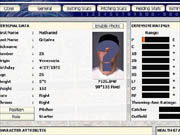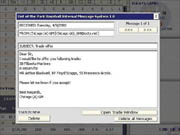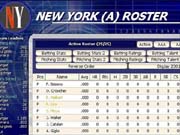Slowly but surely, the Out of the Park Baseball series is moving into Championship Manager territory. Fans of the UK's legendary soccer management simulation know that that's no small accomplishment. One of the best-selling game series in Europe over the past decade, the Championship Manager line has captured the imagination of millions, set new standards for sports sims, and probably even broken up more than a few marriages along the way. Games just don't get more addictive.

Out of the Park Baseball 4 isn't quite at that stage yet. But the big-league management series is getting there, judging by the steady progress made with each new edition. One-man design team Markus Heinsohn has been fine-tuning his approach to provide a game that is more realistic in every area. Most of these improvements are of the minor variety, although they add up to an impressive overhaul that affects all aspects of the gameplay for the better. While a few omissions and some design oddities keep this one out of Cooperstown, there is no better sports management sim on this side of the Atlantic. Mind you, it is only available online at the official Web site.
What makes Out of the Park Baseball 4 so good is its sweeping focus. While rival baseball management series like Diamond Mind and APBA Baseball for Windows are fixated on a single season, Heinsohn's game lets you control teams over multiple years. You can take over the front office of your choice at virtually any point in baseball history and continue for as many seasons as you like. Accurate historical numbers are provided by an importer that adjusts player ratings for the time period selected. For instance, if you want to experience the dead ball era, just dial the beginning of your career back a hundred years. Authentic rosters can be downloaded using files from The Baseball Archive, a free online resource with player information going back to 1871.
There is a lot here even if you're not a historical baseball buff. You can play in single or multiple season mode, with either the default league setup currently used by Major League Baseball or an arrangement of your own using up to 40 teams in as many as two leagues with six divisions. Human players can take the reins of any number of the teams in a league, both on a single machine and via the Net. Online play, first offered in last year's edition of the game, remains a strong attraction. It is similar in feel to the fantasy leagues offered by ESPN.com but with much more interactivity and the welcome absence of subscription fees. As a result, hard-core baseball fans can really lose themselves. It's even easier for commissioners this year, thanks to a new FTP option that permits them to update online leagues in a single step.

The gameplay is true to life from the very beginning. You start from scratch with an off-season signing period in which you compete for coaches and scouts in a bidding war. The competition is cutthroat, and you typically have just one chance at the better people available. Bid high, since you can't really pay too much for the good coaches needed to develop players and the good scouting director required to obtain accurate assessments of players. Scrape the bottom of the barrel and your prospects won't develop on the farm. Even worse, you could wind up with a half-witted head scout who thinks that everyone is surefire pro material. Since much of your success depends on off-season drafting and trading and a 30-day free-agent signing auction, this can be disastrous. Still, the possibility that you're not getting the complete story adds a welcome dimension to the gameplay. Instead of being an omniscient god, you're an all-too-human boss delegating authority to underlings who sometimes don't know what they're doing.
Even when you do have the right people in the right jobs, players can still cause problems. In addition to the traditional statistical categories and skill ratings, each player is given ratings in six character attributes: loyalty, needs winning team, team leader ability, clutch performance, consistency, injury rating. Some of these characteristics are fairly straightforward. Someone with poor loyalty will leave for the first team to offer him more money, and someone who doesn't do well in the clutch can't be expected to contribute a game-winning RBI in the bottom of the ninth. Others lead to uncertain consequences. Wanting to play for a winner inspires a player in good times and brings him down in bad times, while a player with top leadership abilities might run into a "too many cooks" conflict on some teams. The result could be spending too much of your precious budget money on a player who has the right numbers but is still the wrong fit for your club. All in all, you're given a lot to think about. Much more than simple number crunching is required to assemble a winning team.
Fortunately, you're given a lot of information to use in judging players. The menu screens are thorough and professionally designed, though they're somewhat lacking in modern amenities like hotkeys and a back button. All the relevant statistical data is available on demand. The main roster screen for each club contains a wealth of intelligence, including the team leaders in every major statistical category, the stats of all active players in the organization from the big club to the "A" ball farm team, lists of who's hot and who's not, and even the best line of the past seven days. Single clicks on the main menu bar take you to separate screens where you can tinker with the lineup and starting rotation, propose deals or place players on the trading block, fire and hire coaches and scouts, check out team news, and play with finances, which includes the new ability to schedule promotion days (bobblehead dolls, anyone?).

A new e-mail system also helps keep you in the know. It relays trade offers from other teams, reminders from players about their contract status, suggestions from minor league managers on who should be promoted, and even gripes from disgruntled players issuing trade demands. Much of the complexity involved in operating a professional ball club has been broken down into component parts, allowing you to run things like a grizzled boardroom veteran in no time. It also lets you sidestep a lot of chores that could have dragged the game into micromanagement land.
Games can be simmed individually or in day-, week-, or season-long chunks. Simulation speed is nearly instantaneous for single contests, and an average computer can whir through an entire simmed season in under 10 minutes. Games can also be played manually. This is handled via another clean and easy-to-use interface that lets you take on the full range of offensive and defensive bench-boss duties. You make a managerial decision for every at bat. Hitters are told to swing away, bunt for hit, play the hit-and-run, and so on, while pitchers are instructed to go after an opponent, pitch away from him, or hand out an intentional walk. Defensive positioning is also an option in the latter case. How each at bat turns out is depicted in a static picture of a ballpark and described in a text window directly beneath it. Playing a game is much like reading the transcript of a radio broadcast, albeit one in which you have a say over the outcome. Statistical results seem right on target. Everything plays out like you expect--including the actions of the opposing manager--with no wonky results that shake your suspension of disbelief. A few frills even bolster the illusion. Games take the weather into account, for example. Cold, drizzly days lead to players slipping on the wet turf and committing errors. Arguing calls is possible as well, although this can lead to ejection--which means you'll lose control over the rest of the game.
As mentioned earlier, there are some problems that keep Out of the Park Baseball 4 from attaining perfection. The biggest obstacle keeping it from being accepted by a mainstream audience is the absence of the Major League Baseball and Major League Baseball Players Association licenses. Although there are plenty of fan Web sites out there with official rosters, team names, and logos for download, the game comes with fictional players and teams. Some gameplay issues are also evident. Most notably, there is no sound. Purists would claim that audio isn't necessary in a game such as this, but anyone who's experienced APBA Baseball for Windows with Ernie Harwell's Broadcast Blast knows how much this feature adds to replaying games. Even some generic cheers and boos at appropriate times would be an improvement over complete silence. Making matters worse is the subpar quality of the textual play-by-play. Lines are awkward and frequently repeated, there are a few typos, and there is too much reliance on Scooter Rizutto-style catchphrases. Reading "Holy cow!" or "Oh man!" once an inning is a bit much.

Just a few complaints can be lodged about the actual game mechanics. The game occasionally crashes, apparently prompted by odd situations while manually playing games (wild pitches dropped us to the desktop three times). Heinsohn has yet to implement a pitch-by-pitch mode, so hard-core baseball season replayers will have to stick with the likes of Diamond Mind Baseball 8.0 for the time being. This, of course, limits strategic options while manually playing games, particularly in regard to setting up the hit-and-run and stealing, as you're simply given a count for each at bat and then shown what happens. The contracts of managers and coaches cannot be renewed like player contracts, which is particular annoying considering that every third-rate utility man on your roster with an expiring deal sends you e-mail about re-upping throughout the season. Last but not quite least, the game doesn't run quite properly in Windows. Unless you decrease the size of the task bar, the top menu is partially obscured at all times. This has no effect on gameplay, although the obvious flaw will bother the more aesthetically minded.
These rough edges are not enough to cause any disenchantment with Out of the Park Baseball 4 as a whole. The game is a remarkable simulation of running a big-league franchise from the front office to the field, with statistics generation, player movement, and fiscal considerations that are realistic in every way. Addictive as a single-player experience and flat-out irresistible while playing in an online league, it shouldn't be missed.